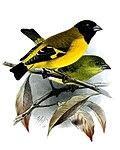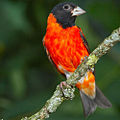Taxonomy
The genus Spinus was introduced in 1816 by the German naturalist Carl Ludwig Koch with the type species by tautonomy as Fringilla spinus Linnaeus, 1758, the Eurasian siskin. [1] [2] The genus name is from the Ancient Greek σπίνος spínos, a name for a now-unidentifiable bird. [3]
All of the species in the genus, except for the Tibetan serin, were formerly included in the genus Carduelis . They were moved to the resurrected genus Spinus based on phylogenetic studies of mitochondrial and nuclear DNA sequences. [4] [5] [6] The Tibetan serin was formerly placed in the genus Serinus . The Eurasian siskin and the Tibetan serin are the only species from the Old World included in the group. [4]
The Tibetan serin is an outgroup within Spinus, having been the first to diverge. [5] The remainder of the genus can be divided into three monophyletic clades: the North American goldfinches (Lawrence's, lesser, and American); the so-called North American siskins (Eurasian, pine, Antillean, and black-capped); and the South American siskins (the remaining 12 species). [7]
The radiation of South American siskins was rapid, and was originally thought to have occurred around 3.5 million years ago due to a range expansion associated with the Great American Interchange and contingent upon the spread of mesothermal plants from the Rocky Mountains to the Andes. [7] More recent work suggests the radiation occurred much later, within the last 1 million years, and speciation events may have been initiated by the climactic variations of the late Pleistocene. [8]
The hooded siskin may be paraphyletic. [8]
Ecology
Spinus finches are gregarious and may breed and forage in small groups. [9] In the non-breeding season, these species generally disperse away from the breeding grounds and small flocks roam nomadically in search of food; these flocks may be of one species or mixed with other species in the genus. Some species, such as the pine siskin and thick-billed siskin, are considered irruptive. [9] [10]
Like most other members of Carduelinae, but unusually amongst songbirds, members of Spinus are primarily granivorous, but may occasionally supplement their diet with insects or fruit. Most species eat a variety of small seeds, especially from asters, grasses, alders, and birches. [9]
This page is based on this
Wikipedia article Text is available under the
CC BY-SA 4.0 license; additional terms may apply.
Images, videos and audio are available under their respective licenses.




















